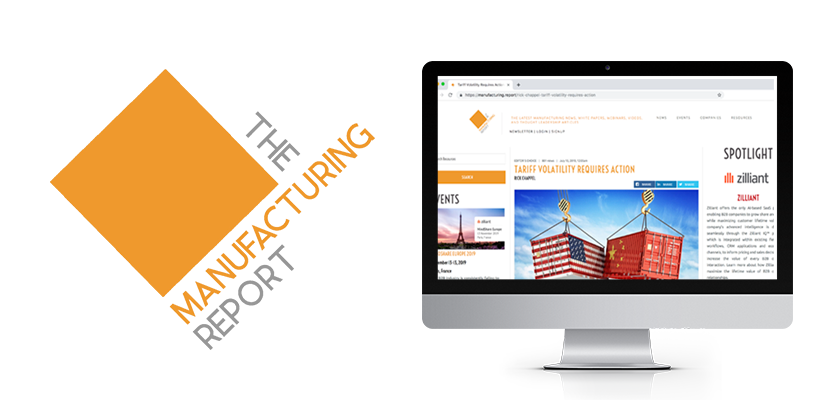
Article was first published on The Manufacturing Report
Volatility is deeply disliked by business leaders. Many manufacturers and distributors face the volatility caused by unpredictable tariffs on Chinese imports and warn of a potential calamity should the Administration’s trade war be expanded.
The uncertainty and exploding costs brought on by these tariffs are affecting business. The automotive, food, building products, electrical, chemical, and myriad other industries have been hit hard, interrupting pricing strategies and overall profitability. New planned tariffs will target consumer goods, but B2B companies have already been broadly affected in costs across the supply chains.
According to Seeking Alpha, “The value of imported goods from China represents about 15% of the value added to US manufacturing.” Those input costs have been rising, creating a ripple effect that impacts almost every business in the manufacturing supply chain.
Raising prices across the board in an effort to preserve margins may be tempting. However, the market remains volatile as tariffs affect separate product components in different ways. Customers may be prone to shop your competitors who may have chosen to eat some or all of the tariff costs, as well as look to source cheaper goods from foreign markets unaffected by tariffs. There is a risk of a sharp sales decline as well as long-term damage from carrying a reputation as overpriced provider reputation. Lydia Di Liello of Capital Pricing Consultants warns there is also the risk of quality degradation from cheapened or unknown supply sources.
Since the length of market turbulence cannot be predicted, the duration and depth of depressed margins also becomes unpredictable. Tariffs are visible market-wide and commensurate price adjustment is easily explained to customers. Price changes can become harder to explain when they are separated from a causal event. Di Liello added, it is critical that these tariffs be captured in some form (price increase or tariff surcharge) to protect profitability in a timely manner. Customers need the ability to track price movement (or tariff surcharge) in tandem with the tariffs for credibility. Not all customers feel the identical impact of tariffs to the prices presented. Price variation must be based on a case-by-case relationship with a specific customer.
Some businesses may be more severely affected by softening markets. Where impacts are more extreme, good managers must take action to preserve the profitability of the company. Non-essential expenses may be cut, and in more severe situations, headcount may be reduced.
During demand softness, costs that were palatable during growth inevitably come under the microscope, as they should. A good price optimization solution becomes an even more critical tool in this environment. While price optimization is often thought of as a method for determining the highest possible price palatable to a customer in a growth environment, optimization solutions also determine the lowest price reduction necessary to retain available business. It prevents reactionary over-discounting and helps achieve the maximum possible profit in a revised volatile market environment. By not over-discounting in response to market softness, companies avoid unnecessary cost-cutting actions.
Di Liello suggests that once discounting becomes a cultural norm, companies stand to lose multiple points of margin as every past deal declined (for poor margin) gets reinstated at even lower prices and margins in a desperate attempt to generate revenue.
Price optimization helps maintain the highest margins in the best and worst of times. Zilliant’s Price IQ leverages AI (Artificial Intelligence) to determine the least discount needed to maintain as much business as possible. The AI solutions pulls in data from a wide variety of internal and external sources to model the right start/target/floor prices for every SKU and every customer.
Tariff volatility emphasizes the need for price guidance that maximizes the profit available, even in a down market. This is invaluable when inputs are uncertain, and far beyond the capacity of manual price-setting. When the company strategy is to maintain share during a downturn, dropping prices across the board may be quick to implement and even feel decisive, but it has an unnecessarily negative effect on profit and revenue.
Blanket price decreases don’t work
Pricing intelligence informs companies exactly how much to drop prices and keep plants utilized and warehouses moving units, without unnecessarily giving away margin.
Find the sweet spot
It is important to remember that price elasticity still exists in a down market. These conditions make it even more important to determine willingness to pay. One must identify the products in which prices can be raised to offset others that are lowered. To find that pricing sweet spot, companies need true elasticity and price sensitivity analytics.
With pricing intelligence demand modeling, companies quickly visualize sensitivity to price and volume changes. It is often smart to make a margin play on an insensitive product by raising the price above tariff costs. With the same strategy, sensitive products will stay on the shelf. Running different strategies concurrently for different products to account for elasticity, only works with real data awareness; this only works by leveraging multiple sources of data to monitor all available price sensitivity signals.
Tariff volatility requires action
The volatility from tariffs mandates an agile and evolving strategy with price optimization. Only when companies run data-driven scenarios and forecast potential outcomes are they able to minimize layoffs and maintain shareholder value.
